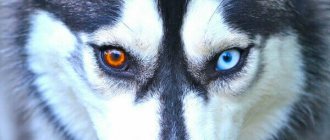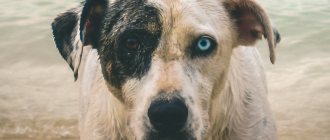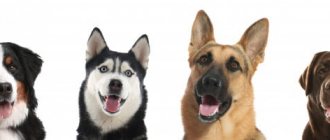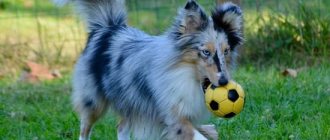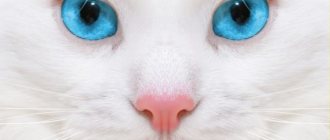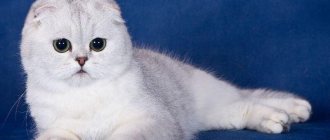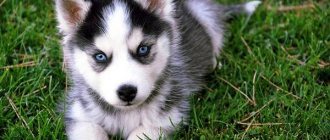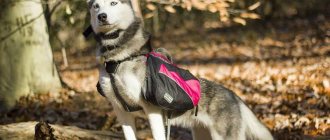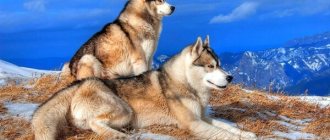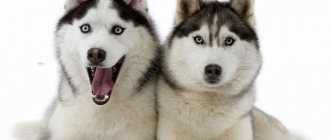These undoubtedly popular and cute dogs attract the attention of animal lovers not only with their soft long hair, pleasant beautiful color and kind, friendly character, but also with their unusual eyes.
The resemblance to a wolf is given by a face frame, or a mask, which can start on the very bridge of the nose and extend onto the forehead. This variety of colors is sure to be found among representatives of the Siberian Husky breed.
Why do huskies have different eyes - blue and brown: the main reasons
In recent years, Siberian Huskies have gained popularity among dog breeders around the world, and simply among those who are not indifferent to these faithful friends and human companions.
And this is not surprising, because this is a very charismatic, majestic and loyal breed of dogs, the individuals of which also have a unique exterior. The color of the eyes also gives dogs of this breed a special coloring of their appearance.
Once you have seen the eyes of a Husky, it is simply impossible to forget this wolf-like, stern and, at the same time, devoted look!
Blue-eyed dogs - breed standard
The most striking feature of this northern breed is, of course, the blue eye color (photo will follow). Previously, they believed that a dog with such an appearance was a defect, since it was believed that such puppies might have visual impairment.
In the exterior of the Siberian Husky breed, the blue color of the iris is the most common and is actually stated as the standard for this particular breed variety. The most common are black and white huskies with blue eyes.
Reference. There is such a variety of huskies as white-haired, which have the same color of the iris. These dogs are a real treasure for dog lovers and are extremely rare. The exterior options also include brown and black eye colors, which is also the norm for pure origin.
Content Features
Dogs of the Siberian Husky breed, of course, stand out among the huge variety of breeds of “human friends”. However, a person who decides to purchase this dog with an unforgettable expressive look should carefully familiarize himself with all the features of raising and keeping this breed.
Such dogs require long active walks; they do not tolerate long stays in a stuffy room, as well as a lack of intense physical activity.
Moreover, the option of keeping a dog year-round in an outdoor enclosure seems to be virtually ideal.
A dog of this breed is suitable for a person with an active lifestyle, a strong, stable character, who has sincere love and respect for his four-legged friend. See the article: Spaniel dog: tips on feeding and maintaining the breed.
Different eye color
The possible relationship of the breed with the Taimyr wolf gives the dog’s gaze a special coldness and mystery, especially if the eyes are blue. But, in addition to the light, sky blue or gray color of the eye iris, the Siberian Husky has black and brown.
It is found very often, has a rich, deep tone and goes well with different nose colors (they are not only black, but also beige, flesh-colored with pink streaks) or the color of the dog’s coat: red, beige and white.
Representatives of other variants of the breed, not Siberian, have eyes that are reddish and light brown, and also with an olive tint.
Special dog
Everything about this breed is special. The deceptive appearance makes the dog a little afraid because of its resemblance to a wolf, but its very kind heart surprises, and its character inspires respect.
Huskies are amazing in both soul and appearance. This creature is a well-deserved favorite of many people, and their diversity will impress even the most bored person.
A reliable companion, a beautiful and amazing animal and an excellent assistant in matters related to physical strength - that’s what this dog is by nature.
Watch the following video for 5 facts about huskies.
The dog is incredibly beautiful with any color of the iris, but the most common representatives are found with multi-colored eyes, for example, brown and blue, as well as olive and deep amber.
Husky with different eye colors
The rarest case is the presence of heterochromia of the eyes, colored differently, which gives the dog’s appearance even more mystery and beauty.
This is a special sign when one eye of a dog is blue and the other is brown, such heterochromia is called complete.
It also happens that one eye can be a completely even tone, without any inclusions, and the second will not only be a different color, but will also include a different shade, as well as spots and dots. This case is called sectoral heterochromia.
What is the name of
Odd-eyed dogs are very popular among breeders, as they are of great interest at various exhibitions. And, in principle, any owner will be pleased to boast of such a faithful friend at home. Huskies with this feature received the nickname Harlequins from dog handlers. They say that such a puppy will bring good luck and happiness to the house.
Origin story
The breed is believed to have originated over 4,000 years ago in Siberia . These were sled dogs bred by the nomadic tribes of the north, as they needed strong and hardy helpers.
Huskies were used not only as sled dogs, but also performed many other functions: they were hunting assistants, watchmen, and nannies for children.
The name "husky" was given in honor of the Eskimo or "Eski" people, who are believed to be the breeders of this breed..
Huskies were registered in 1934 in the USA, and the standard appeared at the same time. It is only thanks to the work and interest of American dog breeders that the breed has survived to this day and gained such popularity.
After all, it was huskies that provided invaluable service to American gold miners at the end of the 19th and beginning of the 20th centuries. Currently, this dog is most often used as a companion.
The history of the appearance of the Siberian Husky breed
Sled huskies in harness are a common sight in the North.
Husky dogs come from the Far East. Their ancestors are Siberian sled huskies. The breed has been bred since Neolithic times by aboriginal tribes who were engaged in fishing and hunting sea life. Thanks to the endurance and strength of dogs, nomadic peoples were able to move around the northern regions, covering vast distances on sleds.
In the 17th-18th centuries, Russians began to actively develop sled dog breeding. To develop the regions of Siberia, they needed reliable transport for the delivery of goods, mail and the movement of officials. A larger number of dogs were required to transport a new type of capacious sled, and therefore the number of huskies increased.
During the “Gold Rush” era, the demand for sled dogs increased among Americans who visited Alaska, and in 1908 they began to import huskies to the United States for subsequent breeding and participation in racing.
Attention! The dogs showed excellent abilities to overcome difficult distances, and it is impossible to count how many heroic deeds they performed.
For example, in 1925, sled dogs saved human lives from death by delivering needed medicine from a train station to the Alaskan city of Nome, where there was an outbreak of a diphtheria epidemic.
This ancient sled dog breed was registered by American cynologists in 1934.
Some historical data
The Siberian Husky breed is one of the oldest, the genomic composition of which differs little from that of a wolf.
The first to tame and domesticate these dogs were the Chukchi.
People in Chukotka used these animals as riding, guard and shepherd animals. Long years of natural selection have produced a healthy, hardy dog breed.
Huskies were first introduced to the states in 1908. During the “gold rush” season, the team with huskies came third to the finish line. After this event, this breed began to be taken more seriously.
The most famous feat performed by this dog occurred in 1925, when the husky dog Balto, in harness with other brothers, along a difficult path of 1085 kilometers, delivered the long-awaited vaccine to the city in order to save the local people of Alaska.However, over time, the Siberian Husky lost primacy in the races to other breeds. Today the entire breed is divided into working, racing and show class representatives.
Most common colors
Huskies with different eyes are actually not that rare. The color of the iris directly depends on the standard that applies to a particular breed. The most common shades for purebred huskies are the following colors:
- blue;
- brown;
- multi-colored.
Huskies with different eyes are not a disease
For your information! Husky eyes cannot be a rich shade of green. A greenish tint is extremely rare and most often is more of a marsh or olive color. The appearance of other colors indicates that the dog is not purebred.
Blue eyes
Huskies with blue eyes are the most common variation and are the standard. Until a certain point, this color was considered defective, since experts thought that blue, almost white irises were a sign of poor vision or even blindness. Of course, this opinion was wrong. However, the blue color of the iris was not specially bred for a long time, so you rarely see it among northern representatives.
Much later, breeders began to specifically cross blue-eyed dogs, which became a sure sign of purebred dogs.
Externally, the eyes look attractive and frightening. The iris is surrounded by a light stripe, making the shade appear brighter. This feature is associated with genetic abnormalities. In this case, no harm is caused to the dog's health.
Note! A puppy born with blue eyes remains that way for life. The shade does not change and does not darken
Lack of pigment in the iris does not affect visual acuity.
Blue-eyed dogs are the most spectacular
Brown-eyed
Huskies with brown eyes are not that common. At the same time, brown-eyed color does not have to be brown. It can range from honey to black. Externally, the color is quite bright, deep and rich. This is because in this case there is enough pigment.
The color of the fur has no effect on the appearance of a brown iris. Brown-eyed puppies can appear in owners of either black or gray or red fur. However, they are found in greater quantities in chocolate and red shades.
Green irises
As already mentioned, there is no husky with bright green eyes. In fact, green is just a tint or an indicator that the dog is not purebred.
For your information! Marsh or amber shades are often found in dogs with light, ash or gray fur.
Gray
A gray tint occurs, especially in dogs with light fur. At the same time, most experts are inclined to believe that this is not a separate color, but only a variation of a blue tint.
This can also happen due to a mutation, due to which the puppy has gray-blue colors. Albino huskies mostly have gray eyes, again due to a lack of pigment.
Common colors
No two huskies are alike: from birth, each puppy has its own coat pattern and color. But you can group the most common suits into separate types.
Black and white
With this type of color, the amount of white and black is approximately equal. The dark part of the coat is on top, the light part is located below. There may be areas with red spots on the back of the thighs.
Black and white color comes in 2 types:
- the hairs are fully pigmented, the shade of the undercoat is gray or black - such dogs look more expressive in person and in photos;
- the hairs are half pigmented, and the undercoat is white or gray.
Red and brown shades
Brown-white
It comes in different expressions - from rich dark to light cream colors. Depending on the concentration of pigment on the hairs, there are 2 subtypes of brown color:
- chocolate – darker and more pronounced;
- copper: lighter than chocolate, different shades - from bright to muted.
In the photo: on the left is a chocolate husky, on the right is a copper one
Red and white
It is also called red. Saturation depends on the pigment concentration. Dogs with bright fur appear fiery, while dogs with muted coats appear light red.
In the photo: fiery red shades (husky on the left, malamute on the right)
Because of this perception of colors, the red color is written as anything - from brown to fawn. This is not considered a mistake. In addition, during the first molt, puppies change color slightly. So don’t be surprised if the color of a pet with a light brown coat is designated as “red” in the passport.
Pale yellow
Close to red. However, it is not saturated, but muted tones - light brown, cream, golden.
Gray shades
Grey
The undercoat can be silver, gray, cream, fawn. And guard hair is found in 3 variations:
- black in combination with white - sometimes this color is considered black and white;
- only the ends of the hair are black;
- the ends of the hair are colored in a non-intense, as if muted black - giving the fur coat a bluish-silver tint.
The latter variation is often classified as a separate color type - silver. Although this is just a variation of the gray color of the husky.
Wolf
It is also called zonal, sometimes and mistakenly called gray. Most of the first representatives of the breed were wolf in color, but breeders relied on other colors, considering them more beautiful.
In the photo: wolf-colored husky. On the right - can also be classified as agouti.
The wolf color combines a beige undercoat with gray guard hair and splashes of brown. Tan marks are most often located on the back of the head, neck, ears, and limbs.
Does eye color change over time?
All newborn husky puppies are blue-eyed. As soon as the baby opens his eyelids, it seems that his cornea is covered with a white coating. This is normal, because it has not fully formed. During this period, the baby sees only light.
The cornea is finally formed on the 25th day from birth. The gaze becomes meaningful and focused.
Over time, the color of the iris changes. It is impossible to say exactly when the change will take place. For some babies, everything becomes clear already at the age of one month. By six months, all husky puppies acquire a permanent eye color. If the irises are still blue by this time, they will remain that way.
Huskies have an unusual appearance, which is why dog breeders all over the world love them. And it’s not just the color and great similarity of sled dogs with wolves.
An anomaly is considered normal for the breed, thanks to which dogs can boast of bright blue, as well as different eye colors.
To this it is worth adding different colors, the main characteristic feature of which is a unique mask.
But do not forget that despite their attractive appearance, northern dogs have a difficult character.
These are sled dogs that need long, active walks. They are not easy to get along with, and without training they become uncontrollable.
I like I don't like1
Do colors change with age?
The color of an adult husky is difficult to predict. The fact is that during the first moults (at 6-10 months) juniors “rebloom” and change color. Whether the original color will remain the same, deepen or become more faded is impossible to predict.
For example, a copper puppy may turn red, while a bright red puppy may turn fawn. The “glasses” that give the look charm may also disappear.
Typically, the color of a husky changes slightly with age: the color fades and becomes less saturated.
Classification and description of husky colors
Interesting! It is believed that pigmentation and character are closely related.
Breeders believe that dog behavior is more influenced by training and education, but not by color. However, scientists are confident that color directly affects the health of animals - the lighter the coat, the weaker the dog’s body.
Red and brown
The pure, rich color of the Husky comes in copper or golden shades. Such dogs are sure to have at least one white spot. Other colors:
- Fawn – dark cream or beige.
- Copper is a transitional color when it is impossible to clearly say whether a husky is red or brown.
- Piebald - small red spots located on a white background.
- Sable - at the base the hairs are light or reddish, and the tips are dark, even chocolate or black.
Pure red individuals cannot be found
Gray
A very common type. The husky's gray color must be pure, and the undercoat can be silver, beige, cream or fawn. The rims of the eyes, pigmentation of the lips and nose are exclusively black according to the standard.
This type also includes a silver color, which completely eliminates the presence of beige shades of the undercoat. It should only be white or silver. The pigmentation of the eyes, nose and lips is also black.
Cheprachny
A saddle blanket is the name given to the lining under a horse's saddle, so the color of a white husky, which has a dark spot on its back, is designated as saddle-back in the classification. The shades of the “saddle” may be different.
Wolf
This is a husky with a wolf-like coloring. The coat may be gray with reddish or yellow markings. Such spots are often located behind the ears, on the withers, forearms, legs, thighs, and hocks. The undercoat of a wolf-colored husky is always beige. The color of the nose, lining of the eyes and lips is only black according to the standard.
Splash
Coloration in the form of a mantle on the back of the animal. Large spots of reddish tints are scattered from the withers to the tail.
Interesting! The white collar stripe around the neck is a distinctive feature of the Husky Splash.
Otherwise, other parts of the body may be gray or brown. Pigmentation of lips, nose, eye contour - black or brown.
Isabella
The undercoat is snow-white, but the tips of the hairs can be red, cream or fawn.
Experts have different opinions about this color. Some classify it as a separate group, others believe that it is simply a white color, which was developed by bleaching fawn and adjacent shades.
Isabella dog
Marble
Black and white huskies are also called “Dalmatians.” The species is rare, because it is believed that marbled dogs are not purebred, and they do not try to breed them. The color is heterogeneous: spots ranging from light gray to black are scattered across the white base. They are located on the back, muzzle, tail, and hips. The nose and lips are brown or black, the rims of the eyes are only black.
Agouti
Siberian Agouti Huskies are bred for racing and as working dogs. This color is not suitable for show class. The coat of the species is gray or black with variations, and sometimes there are red spots on the paws. The undercoat is cream or tan. The pigmentation of the nose, eyes and lips is only black.
Interesting! Features of the Agouti Husky - there are black markings at the tip of the tail, the muzzle is almost entirely dark, with possible inclusions of red and white colors.
Splash coat
Splash coat - translated from English as “dressed in a coat.” Indeed, the back of the husky is covered with a “mantle”, the rest of the parts are snow-white. There is also a known type of pibold, which is considered as a complete analogue of splash coat. Some believe that these are different colors, because white markings predominate in the Peebold and occasionally there are spots of a different color.
What is the reason for the abundance of colors?
Siberian huskies were bred by the Chukchi tribes on the basis of aboriginal dogs - close relatives of wolves. They transported light loads over long distances.
They bred hardy pets that were not afraid of frost and easily tolerated hunger. The emphasis was on working qualities, and appearance was not given importance.
Today the working breed has been “retrained” as a companion. The trend has developed due to the spectacular appearance of dogs: a fluffy coat, a fox tail, erect ears and an expressive face.
Because of their working background, Huskies come in so many colors.
According to the Fédération Cynologique Internationale (FCI) standard No. 270, any color is allowed - from white to black, in any combination of colors, with or without various markings on the head.
Genetics are amazing: future coloring depends on one pigment - eumelanin. It gives the coat a black or brown color. And the combination of color-forming genes determines what color the puppy will be born.
Foreign breeders distinguish about 20 colors of Siberian Huskies. Domestic ones are more conservative and consider only white and its combinations with gray, brown and black to be correct.
But the rest of the husky colors are not a defect. Dogs of this breed are born as diverse as snowflakes.
Unlike colors, everything is clear with wool. The standard allows only straight hair of medium length, with a thick undercoat.
There are opinions that long-haired huskies are not breeds. But that's not true. Long, coarse, shaggy hair hides the dog’s silhouette, it is difficult to care for, mats, takes a long time to dry, and interferes with thermoregulation.
What color are husky eyes?
Eye color must correspond to breed standards. Iris colors characteristic of purebred huskies:
- blue;
- brown;
- multi-colored.
Different shades of the listed colors are possible. There are no huskies with green eyes, but an olive tint is possible. This color is found in brown-eyed dogs.
Other colors are not typical for the breed and indicate that the dog is not purebred.
Blue-eyed huskies
The most popular and most frequently encountered are blue-eyed huskies. Previously, this color of the iris was considered a defect. Breeders were sure that the blue color of the iris indicated blindness or poor vision. Blue-eyed dogs were not allowed to be bred. This is why dogs with blue eyes are rare among other northern breeds.
During breeding work with huskies, breeders, on the contrary, focused on breeding blue-eyed pets, which became the hallmark of the breed.
The iris has a heavenly color and is surrounded by a dark rim. The shade is light, making the animal’s gaze seem piercing and frightening.
This breed feature is associated with a genetic anomaly that does not affect the dog’s health in any way. It occurs due to an insufficient amount of pigment in the iris. Visual acuity does not suffer from this.
All Husky puppies are born with blue irises. You can be sure that a husky’s eyes will remain like this for the rest of his life only when the animal is six months old.
This is why a breeder's assurances regarding a puppy's blue eyes should be treated with caution. Colors characteristic of blue-eyed dogs:
Colors characteristic of blue-eyed dogs:
- black;
- chocolate;
- black and white;
- grey;
- ginger.
White huskies with blue irises are rare. They often have black noses and lips and dark eyes. Albinos are even rarer. They are all white huskies with blue eyes, light lips and nose. The iris is almost white or red.
Brown-eyed huskies
Dogs with brown eyes are not much less common than their blue-eyed counterparts. The color of the iris can vary from honey to black. In brown-eyed huskies, the iris is saturated with a sufficient amount of pigment, so its color is bright and dense.
Amber eye color looks impressive. In certain lighting it appears golden or bright orange, and sometimes has a green tint.
Conclusion and recommendations
Heterochromia is a normal phenomenon that has nothing to do with the dog’s health. A puppy may develop different colored eyes throughout its life. If heterochromia appears in an adult dog, it is better to consult a doctor to rule out serious diseases.
Husky dog eyes
The Husky's eye color, as prescribed by breed standards, requires some variety and can have the following shades:
- Brown.
- Amber.
- Blue.
- Olive.
- Heterochromic (that is, they are different-eyed Huskies, also called “harlequins”).
Individuals with blue eyes
The most common variant of the breed's exterior is the Husky with blue eyes surrounded by a clear dark, almost black rim. Such eyes can be found in black and white, gray and white, and gray individuals.
But white Huskies with blue eyes are quite rare individuals, so true connoisseurs of the breed often dream of purchasing just such a dog. According to dog handlers, blue-eyed white Huskies are the friendliest to humans and love active games and live communication with their owner.
The color of a white dog’s nose can be either black (it harmonizes very nicely with the rim around the eyes!), or a paler brown shade, or even a light cream color.
This transparent, icy look can charm anyone, because dog breeds with blue eyes are very rare. The Siberian Husky is practically the only breed whose standards officially allow this iris color.
Dogs with black and brown eyes
Husky dogs with brown eyes, eyes of a darker, almost black color, are also quite common. At the same time, the color of a brown-eyed individual is, as a rule, more saturated, usually it is predominant black with white splashes.
In addition, there are also individuals with brown eyes, which have a pronounced reddish-amber tint. The coat of such dogs is often brown, of a warm shade, also diluted with white spots or wide stripes.
Heterochromic eye color
Causes ongoing interest among fans of the breed! And this is not surprising, since a puppy or dog with eyes of different colors (usually blue and brown, but other color combinations can occur) looks extremely exotic and extravagant. Such dogs are also called “Harlequins” among dog handlers and fanciers.
However, the question arises, why do Huskies have different eyes, and what could cause this? There may be several reasons for this, but only a veterinarian can provide a reliable answer.
- The most common is hereditary heterochromic iris color, that is, the dog was born with this eye color. The cause of congenital heterochromia is an excess or deficiency of the natural substance melanin, which is responsible for the intensity of color. In addition, puppies resulting from crossing blue-eyed and brown-eyed individuals more often have different eyes.
- However, heterochromia may also occur as a result of illness, or during prolonged treatment with potent drugs. In the event of a random change in the color of a dog's eyes, an immediate medical examination is necessary to determine the cause of the sudden appearance of heterochromia.
Among connoisseurs of this breed, there is an opinion that a Husky with different eyes is a kind of talisman that can bring good luck to its owner’s house. Of course, this fact has not been scientifically confirmed, but if, when choosing a puppy of this breed, the choice fell on the little harlequin, then you can make the purchase without hesitation.
After all, Huskies have different eyes – this is an absolutely acceptable option that does not imply any negative impact on the dog’s health.
Heterochromia and its causes
Dog with blue eyes: beautiful breeds
Many owners call such dogs harlequins. The most well-known color combination for heterochromia is blue and brown. Huskies with different colored eyes appear for two reasons:
- the presence of a genetic predisposition. In other words, the puppy's parents or the next generation had exactly the same feature;
- lack of melanin pigment, which causes the iris to partially lose color.
Note! Owners should understand that the Harlequin Husky is not a deviation from the breed standards, but only a specific manifestation of it. In addition, such a “flaw” does not in any way affect the health or visual acuity of the animal.
In addition, odd-eyed huskies may have a mosaic pattern. In other words, the iris contains several multi-colored elements at once. Such dogs also belong to the standard representatives of the breed and are not a defect.
Heterochromia is appropriate according to the standard
The most common colors of harlequins
There is a legend that thanks to the love between an icy and a hot dog, cute puppies with different eyes were born, one eye of which was colder than the ocean, and the other hotter than fire. Dogs with different eyes have absorbed both icy courage and the warmest kindness of their hearts.
Commonly occurring harlequin iris colors include the following combinations:
Blue and brown. This combination of iris colors in heterochromic huskies is the most common of all. Occurs in dogs with black and white or gray coat color.
Heterochromia in the blue-brown color combination
- Green and brown. This is not a common occurrence among harlequins, so breeders sell puppies with such hereditary heterochromia at a higher price than pets with a combination of blue and brown colors.
- Amber and brown. Representatives with this combination are considered the most resilient during physical activity. Also, thanks to the amber and brown shades of the husky’s iris, the harlequin does not experience additional fatigue from light.
Heterochromia in amber-brown color combination
Gray and blue. The husky has the rarest combination of multi-colored eyes. The look of a husky with light eyes seems as piercing as possible due to the fact that the pupil becomes especially noticeable on the light iris. The gray-blue combination causes some discomfort for the dog, since light irises are more sensitive to light. Especially often the dog has to squint on clear winter days, when the rays of the sun are reflected from the snow.
Heterochromia in the color combination “gray-blue”
Breed standard
It is impossible to meet identical huskies. Dogs have traits that set them apart from other dogs, but there are standard characteristics that are common to any type of this breed.
| Parameter | Males | Bitches |
| Height (at withers) | 55-60 cm | 50-55 cm |
| Weight | 20-30 kg | 15-24 kg |
| Head | Proportional to the size of the body, the skull is rounded at the top | |
| Eyes | Almond-shaped, medium. Color blue, brown, | |
| Muzzle | Standard size, tapers towards the nose | |
| Ears | Large in relation to the entire head, close to each other. The tips point upward and are slightly rounded | |
| Nose | The color depends on the color of the coat. Dark is typical for gray, black, red dogs; brown occurs in orange, flesh-colored, white and gray individuals | |
Expert opinion
Anna Abramenko
An avid dog lover. Experience in veterinary medicine since 2009.
Ask a Question
Scientists at the University of Alaska have proven that husky fur is an indicator of the presence of mercury.
Features of character and intelligence
Both in terms of external appearance and other characteristics, these are the same members of a dog pack as their relatives with the same eye color. The difference in their shade does not in any way affect the animal’s disposition or state of health. Their behavior is peculiar, but it is characteristic of all huskies:
- craving for open space, spirit of freedom,
- the presence of dormant hunting instincts - if you don’t train your pet, he will be kinder than a cat, but after targeted 2-3 sessions he is quite capable of tearing small game to shreds,
- tendency to stubbornness, attempts to dominate,
- the ability to understand gestures and facial expressions of the owner,
- can manipulate a person in order to receive a treat or praise,
- They do an excellent job with the bolts on the doors, and then mask the traces of their mischief.
They have a very kind character and excellent mental abilities. The only negative is gullibility. You should not let your dog out of sight while walking, otherwise it will become a victim of scammers.
Advantages and disadvantages
Pros:
- Brown Huskies are smart and quick-witted.
- These are dogs that can correctly assess the situation and make decisions independently if necessary.
- They look beautiful and impressive, especially if they have brownish-copper colored fur and blue eyes.
- There is no aggression towards people.
- They treat children well: they willingly look after the kids and become excellent companions for them when they grow up.
- They adore their owners and are ready to follow them everywhere.
- They are easy to care for.
- Suitable for both home and apartment use.
- Hardy and quite unpretentious in maintenance and feeding.
Minuses:
- Brown huskies tend to be stubborn at times.
- They love to dig up the earth and are not averse to undermining.
- Predisposed to escape and wandering.
- Out of boredom, they can begin to damage furniture or other things in the house.
- They love to howl like wild predators.
- If not socialized, they can be dangerous to smaller pets.
- Not suitable as a hunting or guard dog.
- They are very mobile and need a lot of physical activity and long walks.
What color should your eyes be? What are these dogs called?
The most common iris color in the Husky breed is blue. Moreover, this color is not light blue, like a person’s, it is rich, bright, with a slight azure tint.
In the exterior of this breed, this color is the most sought after and popular.
However, previously such an appearance was considered a defect, since it was believed that the blue color of the iris indicates a visual impairment.
Later it turned out that this was not so and the blue eye color became the calling card of the breed.
However, there are other iris colors that are considered officially acceptable and comply with the standard, these are:
- Green.
- Amber.
- Gray.
- Brown.
- Black.
In addition, the breed standard allows heterochromicity. That is, a dog can have a different color of the iris, and still be considered a purebred and even take part in exhibitions. Such dogs are also called harlequins.
Life expectancy and what diseases are they susceptible to?
The life expectancy of brown huskies is, on average, 12-15 years. However, they may be susceptible to the following diseases :
- Eye diseases (retinal atrophy, corneal dystrophy, glaucoma, cataracts).
- Eversion or inversion of the eyelid.
- Dermatitis.
- Degenerative myelopathy.
- Diseases of the cardiovascular system.
- Diseases of the genitourinary system (more common in males).
- Respiratory diseases (common in racing dogs).
Brown Huskies, because they love to eat, can be prone to obesity.
Character
Siberian Huskies are friendly, focused on interacting with people, and love to play with children. Very neat and clean.
The working past remains in the character of Siberian dogs to this day - they are tireless and active, they love to drag heavy objects. When buying a husky, remember: she will never become a lazy sofa dog and will require long walks in constant movement.
A bored husky can turn the owner's home into a haven of chaos with piles of things scattered in the corners, chewed furniture legs and torn wallpaper. The dog hunts with pleasure, but does not bring prey. She has fun with small animals and birds on her own.
When do puppies open their eyes after birth?
Husky puppies are born blind. Their eyelids are underdeveloped. At first, the baby focuses on hearing, and the mother takes care of him.
Babies begin to open their eyes 10-14 days after birth. Most often, both eyes open at once. But it happens that one is late for a couple of days - this is considered the norm.
All puppies develop differently, so a slight delay is not a reason to panic.
If the baby is still blind at 18-20 days from birth, the husky's eyes should be rinsed with clean water. Inflammation or redness indicates health problems for your pet. The baby needs to be shown to a specialist.
Important! If your puppy is 30 days old and his eyes are still not open, you should consult a doctor.
Different iris color
The standard allows other variations.
Green irises
The breed standard allows greenish shades of the iris. The tints of green are more likely to be an olive color, a derivative of amber. The green in a husky's eyes can be seen from certain angles in bright sunshine, but there is no such thing as an iris the color of green grass.
Husky with green eyesBlue-eyed huskies
Huskies with blue eyes are the most popular among breed lovers. The iris of blue-eyed dogs has a heavenly color and is surrounded by a black rim. The light iris of the blue-eyed representatives of the Husky breed makes the dog’s gaze piercingly threatening and at the same time incredibly attractive. The genetic anomaly resulted from a mutation in the genome that resulted in a lack of pigment in the iris. However, this feature of the dog’s exterior does not in any way affect the quality of their vision.
Interesting! Previously, such a husky appearance was considered a defect, and blue eyes in dogs were explained as a sign of visual impairment. Blue-eyed husky
Grey eyes
Representatives with gray eyes are not found as often as others. The coat color of gray eyes is usually close to slate and emphasizes the beauty of the husky's eyes. The color of the iris varies from deep dark to very light gray. The rare color of the iris is truly unique; you want to look at them for a very long time.
Gray-eyed husky
Brown-eyed huskies
Dogs with brown eyes have irises ranging from warm honey to black. Due to the rich pigmentation of the iris, its color appears dense and quite bright. The amber tint in brown-eyed dogs looks especially impressive.
Interesting! In different lighting conditions, the eyes may appear orange, red, golden, or even have a greenish tint. Brown-eyed husky
Silver-white (albino eyes)
Albino husky eyes are colorless, as is their coat. Individuals with albinism are born extremely rarely and have a silvery-white iris. The edges of the snow-white husky's eyelids, outlined as if drawn with a pencil, emphasize the silver-white color of the eyes against the background of an absolutely white coat, which gives the dog's exterior a fabulous look.
Albino husky eyes
Non-standard coat and eye colors
The standard for this breed dated January 24, 2000 No. 270 does not contain information regarding the shade of the iris and coat color, which could be considered defects. These animals' eyes can be any color. Contrary to erroneous belief, heterochromia is not a disqualifying defect. As for color, various options are acceptable - from snow-white to completely black.
Share with friends!
Features of the suit
The appearance of dogs of this color is, first of all, a light, aristocratic appearance. The dogs are active and love an active lifestyle and walks in the fresh air. They easily find a common language with other animals and are able to act together, for example, in a common team.
Males are rightfully considered stronger and more resilient. They are larger in size and have a more powerful backbone. Females, on the contrary, are more graceful and fragile, but female representatives of this color cannot be called weak.
Huskies are medium-sized animals with very thick hair and a dense undercoat. They have straight ears, and their tail is more like a huge feather. Dogs of average build, and with proper care and feeding regimen, do not suffer from excess weight. But all this is not the main thing when it comes to huskies. After all, the whole world fell in love with dogs not for their size, coat color or feather-like tail. A husky's pupils are a pet's real asset. They fascinate, impress, and sometimes their gaze sends a chill through your skin.
Care
Caring for such representatives is no different:
- Treatment of eyes from excess secretion 2 times a week, using a specialized lotion for dogs, it can be purchased at any veterinary store. Or by independently preparing a decoction of herbs with an antiseptic effect (chamomile).
- The decoction should not be hot or too cold; you will need to moisten a cotton pad or haze cloth in it, and then wipe your eyes: from the inner edge to the outer, removing accumulated secretions.
When do dogs change their teeth?
Between 3 and 7 months, puppies begin to lose their baby teeth and their permanent teeth begin to grow. As soon as the baby tooth falls out, a permanent tooth appears in the socket and grows very quickly. Sometimes there are cases when the milk ones have not yet fallen out, but permanent ones grow nearby. In this case, you need to contact a veterinarian in order to remove them, otherwise the dog may develop an abnormal bite.
The first, at 3 months, to fall out are the primary incisors, at 4 months the molars are replaced, and by 6 - 7 months the puppy has permanent canines and molars.
During the period of teeth change, the dog chews a lot and indiscriminately. To prevent damage to your things and furniture, she needs to be given small veal bones and cartilage. And your diet should contain foods containing sufficient amounts of calcium.
When a dog's teeth change, it is advisable to show the dog to a veterinarian. If you are planning to show your dog, proper bite and dental condition are very important.
My Jolly's teeth changed without any problems. However, they later noticed that she had one extra upper incisor, and the veterinarian suggested removing it under anesthesia. But knowing that her blood clots quite poorly, I didn’t take any risks, especially since we don’t participate in exhibitions.
Many dog breeders say that when dogs change teeth, they, like children during teeth change, experience digestive disorders and even fever.
Our Chihuahua's teeth change went through without any particular difficulties, although during the period of teeth change he chewed absolutely everything that caught his eye. Therefore, in addition to bones and cartilage, I advise you to stock up on a couple of special toys for puppies. But if your puppy grows teeth in two rows, then I would not advise you to immediately panic and go to
Source
If the dog is red
A dog that is red or golden in color is a sign of wealth. Such animals were always greeted joyfully and believed that they carried good news. There are also certain signs and beliefs with these pets:
- A red dog came to the house - expect an improvement in your financial situation.
- Good news comes from a red dog that barks at you or sits near the door of your house.
- If you have such a pet, expect regular bonuses and cash receipts.
- If your pet happily barks at the front door, then unexpected guests will soon come to you.
- The appearance of an amber animal in the house of an unmarried girl means the appearance in her life of a passionate admirer with serious intentions.
- If a dog appears in a man’s house - to a new business partner who requires special attention.
- Meeting a red dog on the street means receiving a one-time financial reward.
Breeds and types of dogs of the north
Basically, all dogs of northern origin are sled dogs that look like a wolf, with a strong build and beautiful coat. There are three main breeds of sled dogs: Husky, Malamute and Samoyed.
Differences between Malamute and Husky breeds
What are the differences between a malamute and a husky, what distinctive features are characteristic of them?
Answering the question of what is the difference between a Malamute and a Husky, it should be noted that Huskies are faster dogs, while Malamutes are strong individuals capable of carrying heavy loads. Representatives of the Husky breed are designed to travel long distances with high speed but light load.
The Alaskan Malamute is a strong dog with a powerful build and well-developed muscles. The Siberian Husky is a fast, agile dog of medium build that maintains a balance of speed and endurance.
The standard height of a husky is 50-56 cm, weight – 16-28 kg. The Malamute reaches a height of 58.5-63.5 cm at the withers, its weight is 34-38 kg.
Siberian huskies are more varied in color than their “Alaskan brother.” “Siberians” can be of almost any color, ranging from black, brown, all the way to snow-white. “Alaskans” can also be different in color, combining gray, black, sable, brown shades, but only white can be an acceptable solid color.
What types of huskies are there?
All huskies are sled breeds, incorporating several varieties of dogs with common characteristics, but different from all other varieties, history of origin, habits and appearance.
Today the husky dog is represented by the following species:
How do they socialize?
Huskies treat their owners with warmth and tenderness. They love communicating with people or with their relatives. You should be careful so that the dog does not fall into the hands of kidnappers.
She is not suitable as a security guard. The exception is when the animal goes through all stages of quality training. Most of all, pets with heavenly or brown eyes are suitable for family entertainment and a pleasant pastime with their participation.
Relationships with other animals
Representatives of this breed are pack dogs, so they prefer cheerful company. They get along well with their brothers, even if they are not the same breed. They get along well with cats. A kitten that grows up with it has a better chance of making friends with a dog. Older dogs can take children under their care.
How do they behave with children?
This is an ideal option for families with children. Huskies will find a common language with toddlers, preschoolers or teenagers. You can safely trust them to look after the children while you are busy with household chores. They love to play together and become good friends.
Pets with a beautiful fur coat and heavenly gaze have an unusual timbre of voice and manner of producing sounds. They don't bark. Instead, you can hear a soft sound reminiscent of a melody. This gives them the opportunity to calm and lull crying babies with their voice.
How to choose?
First of all, you should not buy a puppy on a whim. Having decided to purchase a pet, you need to start looking for a nursery or breeder who breeds huskies.
Even if the dog is needed only as a companion, it should be purchased from a nursery or through a club, and the baby must have a veterinary passport and medical certificate.
When choosing a puppy, you should pay special attention not only to its appearance, but also to its behavior, character and temperament.
Huskies are already very active and emotional, so if the future owner does not want a small living hurricane to settle in his house, then he should not opt for a hyperactive baby, but rather choose a calmer puppy.
A little husky should be moderately playful and active; it is also very important that he does not show aggression or cowardice in the presence of people. And, of course, he should not have even the slightest signs of ill health .
As for the characteristics of this color, it is desirable that on a brown background there are white markings on the head, muzzle, neck, chest, belly and lower legs.
This coloring of brown huskies looks very impressive and elegant and is usually a success at exhibitions.
When do dogs change their teeth?
Between 3 and 7 months, puppies begin to lose their baby teeth and their permanent teeth begin to grow. As soon as the baby tooth falls out, a permanent tooth appears in the socket and grows very quickly. Sometimes there are cases when the milk ones have not yet fallen out, but permanent ones grow nearby. In this case, you need to contact a veterinarian in order to remove them, otherwise the dog may develop an abnormal bite.
This is interesting: Childbirth Cats
The first, at 3 months, to fall out are the primary incisors, at 4 months the molars are replaced, and by 6 - 7 months the puppy has permanent canines and molars.
During the period of teeth change, the dog chews a lot and indiscriminately. To prevent damage to your things and furniture, she needs to be given small veal bones and cartilage. And your diet should contain foods containing sufficient amounts of calcium.
When a dog's teeth change, it is advisable to show the dog to a veterinarian. If you are planning to show your dog, proper bite and dental condition are very important.
My Jolly's teeth changed without any problems. However, they later noticed that she had one extra upper incisor, and the veterinarian suggested removing it under anesthesia. But knowing that her blood clots quite poorly, I didn’t take any risks, especially since we don’t participate in exhibitions.
Many dog breeders say that when dogs change teeth, they, like children during teeth change, experience digestive disorders and even fever.
Our Chihuahua's teeth change went through without any particular difficulties, although during the period of teeth change he chewed absolutely everything that caught his eye. Therefore, in addition to bones and cartilage, I advise you to stock up on a couple of special toys for puppies. But if your puppy grows teeth in two rows, then I would not advise you to immediately panic and go to
Source
Husky puppies (photo): care, feeding, education
The charming appearance of husky leaves no one indifferent, especially if their cute face and thick paws are accompanied by a piercing blue gaze.
The external attractiveness of husky babies, which are similar to Alaskan Klee Kais , has played a cruel joke on many representatives of this breed.
Random people who do not know the characteristics of this breed acquire a fluffy wolf cub, raising it as an ordinary decorative dog, and are quickly disappointed.
The Husky is a truly working dog, requiring daily exercise and exercise, freedom-loving and mischievous, with great potential and indomitable energy.
But if the potential owner is ready for difficulties, ready for work and loves sports, then the Husky will be an ideal companion for ten years or more.
Choosing a Husky Puppy
All these criteria are only partly true, since the baby’s color is unstable and will change in a couple of years, fatness only means that the pet has an excellent appetite, and the behavioral characteristics of females and males may not differ much.
This is justified if you buy a show pet, since the older the baby, the more clearly all the advantages and disadvantages of the exterior are visible, besides, raising in a pack of littermates helps to better adapt to any conditions.
Babies that are promising for exhibitions can be recommended by a breeder who wants their excellent potential not to be wasted just like that.
Experienced Husky owners, when purchasing an animal, make sure that the baby meets the standard and has the makings of a working dog.
Choosing a husky puppy from a large nursery with excellent recommendations and results from exhibitions and competitions is preferable to purchasing from an amateur breeder.
This is due to the fact that the nursery owner leads
Source
online now
We are VKontakte
Signs with a white dog
Husky eyes. photo of a husky with blue eyes. puppies
White color has always been associated with something bright, positive and pleasant: love, luck, luck and success in business.
The most common signs associated with a white dog are:
- If a white dog barks at you, then you will soon receive a good income.
- A young girl meets a dog of this color, which means she will soon get married.
- Meeting three white dogs at once will bring unprecedented luck.
- Out of the corner of our eye we saw a milky white animal - the whole day will be full of luck.
- I dreamed of a white dog - you will witness a fateful event
- A dog of this color crosses your path - expect great success.
- If you met a friendly white dog, this means that your problems will be solved with the help of your family and friends, without your participation.
- An aggressive white dog promises an unexpected action from your good friend.
- We met a white dog with gray eyebrows - you have a protector from evil spirits.

